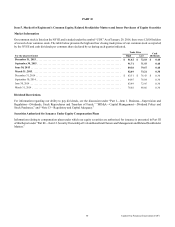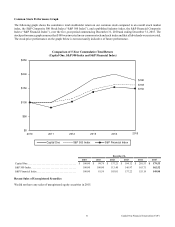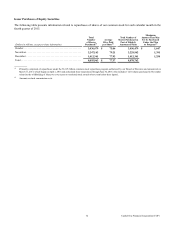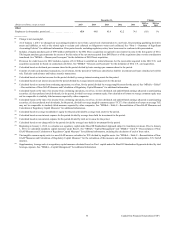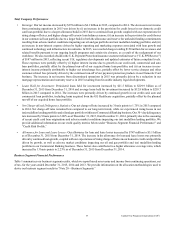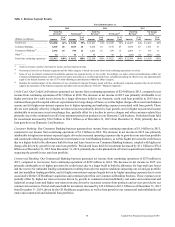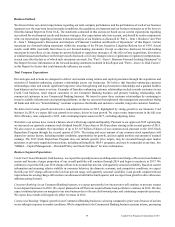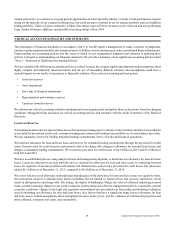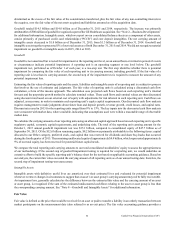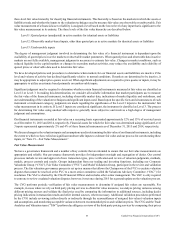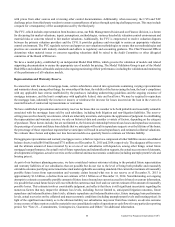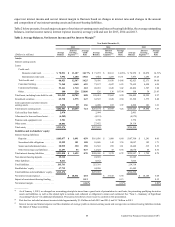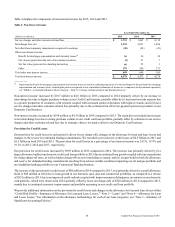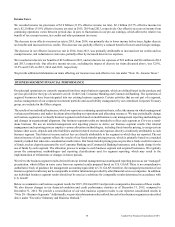Capital One 2015 Annual Report Download - page 59
Download and view the complete annual report
Please find page 59 of the 2015 Capital One annual report below. You can navigate through the pages in the report by either clicking on the pages listed below, or by using the keyword search tool below to find specific information within the annual report.
40 Capital One Financial Corporation (COF)
margin and returns, we continue to see good growth opportunities in select specialty industry verticals. Credit performance remains
strong for the majority of our commercial businesses, but credit pressures continue in our oil and gas portfolio and taxi medallion
lending portfolio. Unless oil prices rebound it is likely that energy loans will drive increases in our criticized and non-performing
loans, further allowance additions, and possibly increasing charge-offs in 2016.
CRITICAL ACCOUNTING POLICIES AND ESTIMATES
The preparation of financial statements in accordance with U.S. GAAP requires management to make a number of judgments,
estimates and assumptions that affect the amount of assets, liabilities, income and expenses on the consolidated financial statements.
Understanding our accounting policies and the extent to which we use management judgment and estimates in applying these
policies is integral to understanding our financial statements. We provide a summary of our significant accounting policies under
“Note 1—Summary of Significant Accounting Policies.”
We have identified the following accounting policies as critical because they require significant judgments and assumptions about
highly complex and inherently uncertain matters and the use of reasonably different estimates and assumptions could have a
material impact on our results of operations or financial condition. These critical accounting policies govern:
• Loan loss reserves
• Asset impairment
• Fair value of financial instruments
• Representation and warranty reserves
• Customer rewards reserves
We evaluate our critical accounting estimates and judgments on an ongoing basis and update them, as necessary, based on changing
conditions. Management has discussed our critical accounting policies and estimates with the Audit Committee of the Board of
Directors.
Loan Loss Reserves
We maintain an allowance for loan and lease losses that represents management’s estimate of incurred loan and lease losses inherent
in our held-for-investment credit card, consumer banking and commercial banking loan portfolios as of each balance sheet date.
We also separately reserve for binding unfunded lending commitments, letters of credit and financial guarantees.
We build our allowance for loan and lease losses and reserve for unfunded lending commitments through the provision for credit
losses. Our provision for credit losses in each period is driven by charge-offs, changes to allowance for loan and lease losses, and
changes to unfunded lending commitments. We recorded a provision for credit losses of $4.5 billion in 2015 and $3.5 billion in
both 2014 and 2013.
We have an established process, using analytical tools and management judgment, to determine our allowance for loan and lease
losses. Losses are inherent in our loan portfolio and we calculate the allowance for loan and lease losses by estimating incurred
losses for segments of our loan portfolio with similar risk characteristics and record a provision for credit losses. The allowance
totaled $5.1 billion as of December 31, 2015, compared to $4.4 billion as of December 31, 2014.
We review and assess our allowance methodologies and adequacy of the allowance for loan and lease losses on a quarterly basis.
Our assessment involves evaluating many factors including, but not limited to, historical loss and recovery experience, recent
trends in delinquencies and charge-offs, risk ratings, the impact of bankruptcy filings, the value of collateral underlying secured
loans, account seasoning, changes in our credit evaluation, underwriting and collection management policies, seasonality, general
economic conditions, changes in the legal and regulatory environment and uncertainties in forecasting and modeling techniques
used in estimating our allowance for loan and lease losses. Key factors that have a significant impact on our allowance for loan
and lease losses include assumptions about unemployment rates, home prices, and the valuation of commercial properties and
other collateral, consumer real estate, and automobiles.


